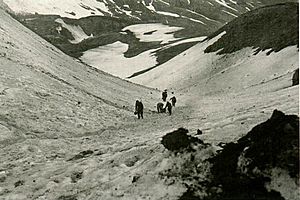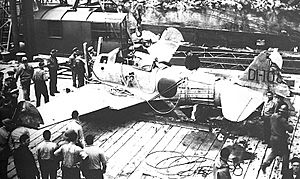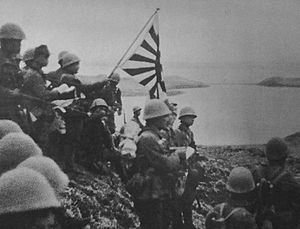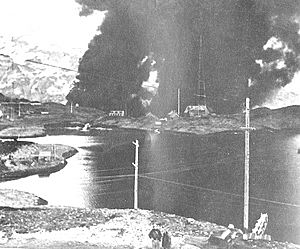Aleutian Islands campaign facts for kids
Quick facts for kids Aleutian Islands campaign |
|||||||
|---|---|---|---|---|---|---|---|
| Part of the American Theater and Pacific Theater of World War II | |||||||
 American troops hauling supplies through Jarmin Pass on Attu in May 1943. Their vehicles could not move across the island's rugged terrain. |
|||||||
|
|||||||
| Belligerents | |||||||
| Commanders and leaders | |||||||
| Strength | |||||||
| 144,000 | 8,500 | ||||||
| Casualties and losses | |||||||
|
1,481 killed
US Navy vessels lost:
|
4,350 killed
|
||||||
| 2 civilians killed, 46 captured (16 died in captivity) | |||||||
The Aleutian Islands campaign was a series of battles fought during World War II. It took place in the Aleutian Islands of Alaska, a territory of the United States. This campaign involved forces from the United States, Canada, and Japan. It started on June 3, 1942.
During this campaign, a small Japanese force took over two islands: Attu and Kiska. These islands are very remote, and the weather and land were very difficult. This made it hard for a larger American and Canadian force to remove the Japanese for almost a year.
The Japanese believed that controlling the Aleutian Islands would stop the U.S. from attacking them across the Northern Pacific Ocean. The U.S. worried that Japan would use the islands as bases to launch air attacks on cities like Anchorage, Seattle, San Francisco, or Los Angeles.
A major battle to take back Attu began on May 11, 1943. It ended on May 29 after a final Japanese attack. On August 15, 1943, a large force landed on Kiska. They had bombed the island for three weeks, but they found that the Japanese had already left on July 29.
This campaign is sometimes called the "Forgotten Battle." This is because other big events in World War II often get more attention. Some historians think the Japanese attack on the Aleutians was a trick to draw American ships away from the Battle of Midway. Others believe Japan wanted to protect its northern border.
Contents
Japanese Attack on the Aleutians
Before Japan joined World War II, its navy had learned a lot about the Aleutian Islands. However, they didn't have current information about U.S. military bases there. Admiral Isoroku Yamamoto led the Japanese plan. He sent a fleet with two aircraft carriers, five cruisers, twelve destroyers, and six submarines.
This fleet, led by Vice-Admiral Boshiro Hosogaya, was ordered to attack Dutch Harbor from the air first. Then, they were to land troops on Adak, an island about 480 miles (770 km) west. The Japanese didn't know that Adak was not defended by U.S. forces. After Adak, the troops were to be ready for two more landings: one on Kiska and another on Attu, the westernmost island.
The U.S. Navy had cracked Japanese secret codes. Because of this, Admiral Chester Nimitz knew about Japan's plans by May 21. He knew about the Aleutian invasion, the size of the Japanese fleets, and when the attack would start.
By June 1, 1942, the U.S. had about 45,000 troops in Alaska. Around 13,000 were at Cold Bay and two Aleutian bases: Dutch Harbor and Fort Glenn Army Airfield on Umnak Island. The U.S. Army Air Force had bombers and fighter planes ready. The naval commander was Rear Admiral Robert A. Theobald.
When the U.S. learned of the Japanese fleet approaching Dutch Harbor, they sent out planes to find and attack it. They wanted to sink the Japanese aircraft carriers. On June 2, a U.S. plane spotted the Japanese fleet. However, bad weather soon moved in, and the U.S. planes lost sight of the enemy fleet.
Attack on Dutch Harbor
Japanese intelligence thought that the closest American air base was far away. They believed Dutch Harbor would be an easy target for their strong fleet. This attack was part of a larger plan that included capturing Midway Island.
Using the cover of bad weather, the Japanese launched an air attack on Dutch Harbor on June 3, 1942. This was the first time the continental United States was bombed from the air in history. Only half of the Japanese planes reached their target. The others got lost in the fog or crashed.
Seventeen Japanese planes found the naval base. They faced strong anti-aircraft fire and American fighter planes. Surprised, the Japanese quickly dropped their bombs and left. They caused little damage that day.
On June 4, the Japanese returned to Dutch Harbor. This time, their pilots were better organized. After the attack, oil tanks were burning, the hospital was partly destroyed, and a barracks ship was damaged. American pilots tried to sink the Japanese carriers, but bad weather stopped them. The weather also forced the Japanese to cancel their plans to invade Adak.
Japanese Occupation of Kiska and Attu
The Japanese invaded and took over Kiska on June 6 and Attu on June 7, 1942. This shocked the American public. It was the first time the continental United States had been invaded since 1815.
The Japanese forces met little resistance at first. The local people, called Unangax (also known as Aleuts), were not harmed much until September 1942. Then, the Japanese changed their plan. They took the Unangax people from Attu to Hokkaido, Japan. There, they were held in a camp.
Because of this, the U.S. decided to move all Unangax civilians from the other Aleutian Islands. They were taken to camps in the Alaska Panhandle for their safety.
Aftermath of the Campaign
After the campaign, U.S. forces considered attacking northern Japan. While full invasions didn't happen, over 1,500 air missions were flown against the Kuriles. These attacks forced Japan to keep many planes and troops in the area.
This campaign was also important for Canada. It was the first time Canadian soldiers who had been drafted (conscripts) were sent to a combat zone in World War II. The Canadian government had promised not to send draftees "overseas." However, the Aleutians were considered part of North America, so they could be sent there.
The campaign also saw the first use of the 1st Special Service Force, a special unit. However, they did not see any fighting in the Aleutians.

In the summer of 1942, the Americans found an almost complete Japanese Zero fighter plane on Akutan Island. This plane, known as the Akutan Zero, was repaired. It became the first Zero that the U.S. could test-fly during the war. This helped American pilots learn how to fight against the Zero more effectively later in the war.
Remembering the Fallen
During the campaign, two cemeteries were made on Attu for those who died. After the war, in 1946, all American remains were moved. They were either sent home to their families or to Fort Richardson near Anchorage, Alaska. On May 30, 1946, a special ceremony was held to honor the soldiers.
Veterans' Stories
The 2006 documentary film Red White Black & Blue tells the stories of two veterans from the Attu Island campaign, Bill Jones and Andy Petrus.
The famous writer Dashiell Hammett served as an Army sergeant in the Aleutian Islands during World War II. He worked on an Army newspaper there. He later wrote a book about the campaign called The Battle of the Aleutians.
Legacy of the Campaign
Many places involved in the Aleutian Islands campaign are now important historical sites. The battlefield on Attu and the Japanese occupation site on Kiska are special landmarks. They are part of the Aleutian Islands World War II National Monument.
Parts of the old military bases at Adak, Umnak, and Dutch Harbor are also historic landmarks. The shipwrecked SS Northwestern, which was damaged during the Dutch Harbor attack, is also listed as a historic place.
|
See also
 In Spanish: Campaña de las Islas Aleutianas para niños
In Spanish: Campaña de las Islas Aleutianas para niños




